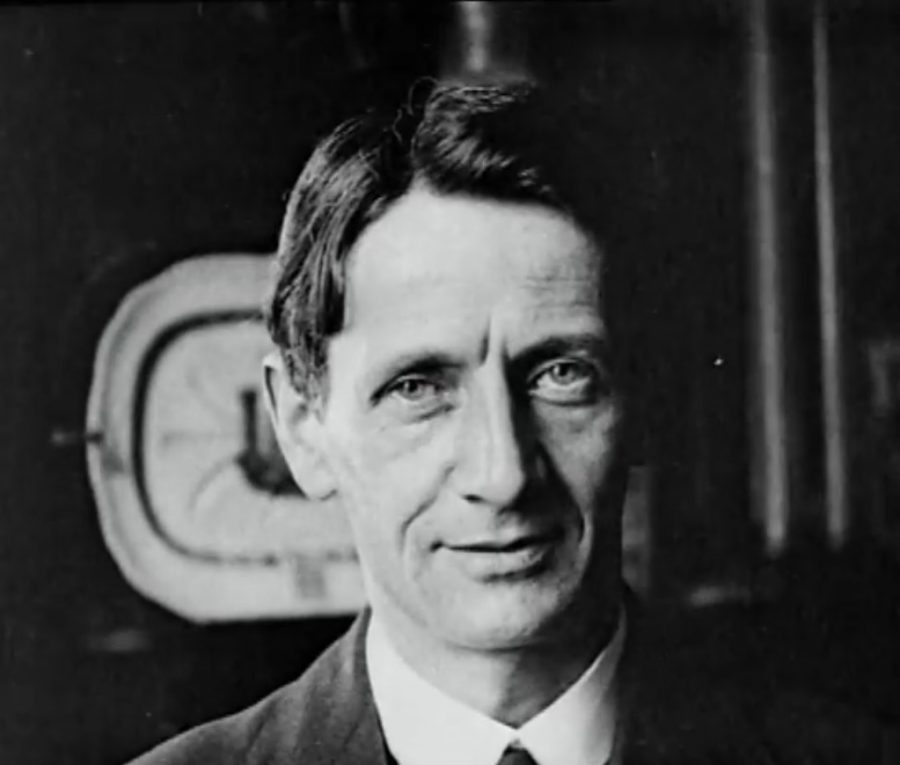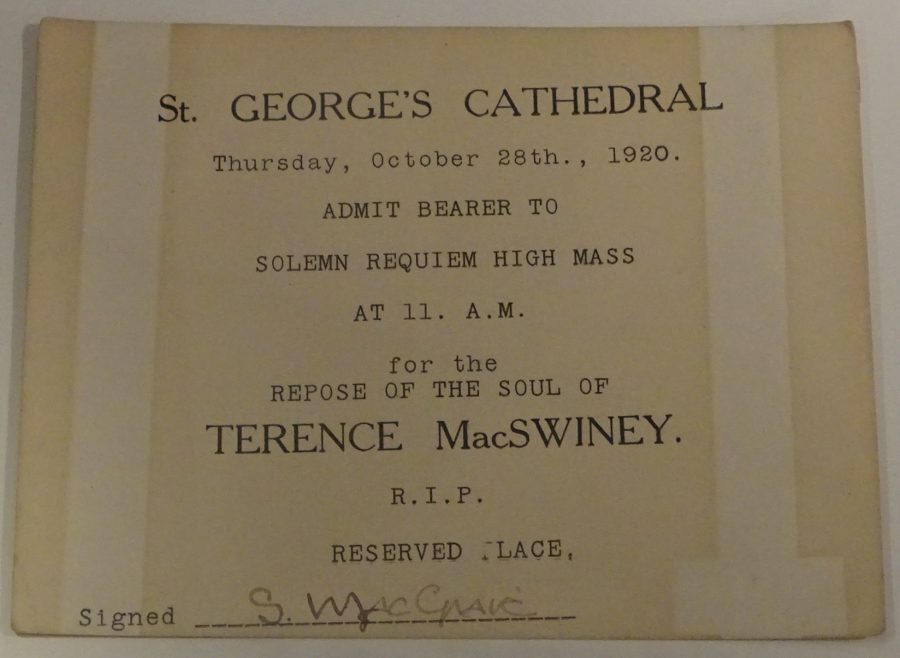
1072a. Lord Mayor Terence MacSwiney, Spring–Summer 1920 (source: Cork City Library).
Kieran’s Our City, Our Town Article,
Cork Independent, 29 October 2020
Remembering 1920: Terence MacSwiney’s Return to Cork
Once St George’s Cathedral at Southwark, London opened its doors on Thursday 28 October, tens of thousands flocked in to see Terence MacSwiney’s body. Many were Irish or of Irish extraction. Mass was fixed for 11am, which was a ticketed affair. Police had to link arms to prevent those with no tickets from pushing their way in. Six men wearing long coats presented tickets to the policemen and once inside took their coats off to reveal that the green unformed members of the IRA. They replaced their colleagues as the honour guard by the coffin. Muriel was too sick to attend or to travel back to Ireland. Two of Terence’s sisters Margaret and Kit (both nuns) did not make it from America or Tokyo respectively.
After the Requiem, the procession of the coffin on the horse-drawn hearse, which was almost a mile long – began for Euston Station. Terence’s two brothers and two sisters reached Euston Station at 4.30pm. On arrival at the station, the siblings were informed the train was due to leave at 4.45pm. They had arranged to travel by the 6.20pm train. After they had accompanied Terry’s body to a good’s carriage van they hurried down the platform to their carriage. Without notice, the train changed to be a special train to leave at 6pm. The train was also crowded with police in every carriage.
A train guard came to family friend Art O’Brien and said the police Inspector wished to speak to him. The inspector was looking for Muriel and noted that he had a communication for her but could not make it until they had passed Crewe.
Soon after Crewe the Inspector visited the MacSwiney delegation again and gave a letter from Chief Secretary for Ireland Thomas Hamar-Greenwood, addressed to Muriel. Opening it they found a copy of a letter addressed to the Press to the effect that, owing to a possibility of trouble, the Government had ordered that the remains should go straight to Cork. They were utterly taken aback and began to lecture them on their duty to the dead and the sacredness of the dead. The family noted that the Lady Mayoress was in London and they could take no decision without consulting her, and that the coffin should remain in Holyhead while someone went back to lay the facts before her. The request was turned down and the transport of the body continued to the English coast bound for Cork.
The train reached Holyhead, about midnight. The family had arranged that all should go at once to the van where Terry’s body lay. The train stopped at the town station, and it was there the SS Kenmare, was immediately waiting to depart. Family friend Art O’Brien produced the contract of the railway to take Terence’s body via Kingstown, to Cork, and he ordered them to carry it out. The stationmaster said he would go to the telephone, but the police inspector had a talk with him and said it was a Government order, that he should not carry out the contract.
Subsequently the family joined hands around the coffin but the door near the coffin was opened and railwaymen came in and took away the wreaths, while police and Black and Tans and ordinary military lined the platform. The family did not try to prevent them taking the wreaths. The railwaymen came towards the coffin and, almost in unison, they all said: “Don’t dare touch that coffin, we forbid you to touch it”. On that, they all left the van and said to the police: “We are forbidden to touch the coffin”. On that, the police rushed forward, pushed the family to one side and away from the coffin and surrounded it. The coffin was lifted out of the van and onto the steamer, the HMS Rathmore leaving the family on the quayside looking on.
The MacSwiney family were forced to get the train for Holyhead and get a separate steamer there. The journey to Dún Laoghaire was quiet. On Friday 29 October they assisted at High Mass for Terence in Dublin without the coffin present. After the Mass, the family delegation went in funeral procession behind the empty hearse that Terence’s body should have lain in to Kingsbridge. They left for by train for Cork at 2pm.
Meanwhile back in Cork, within four hours of Terence’s death, large written notices were erected outside the Offices of the Cork Examiner and Cork City Hall, which caused a thrill of sorrow throughout the city. By mid-morning the streets of Cork were filled with people who wore Republican rosettes with black crepe. The Municipal and Harbour Board flags flew at half-mast, and most of the city’s establishments had their premises partly shuttered. Most of the ships in the harbour had their flags at half-mast. All public functions were cancelled, and theatres and other such amusement spaces closed.
A special meeting of Cork Corporation was convened where councillors expressed their condolences and raw emotion at losing the City’s Lord Mayor. The Deputy Lord Mayor Councillor Donal Óg O’Callaghan issued the following statement, decrying that despite Terence’s death, the merit of Republicanism will still linger and pass on:
“In the short interval since his imprisonment, while I have been temporarily taking his place, I have received notices of official origin threatening me with a similar end. The only message that I on behalf of the Republicans of Cork give today over the corpse of the late Lord Mayor is that Cork has definitely not yielded its allegiance to the Republic, that the people of Cork will continue that allegiance unswervingly and that those of us who man the Municipal Council will attempt as far as us lies to follow the noble and glorious lead of the two martyred Republican Magistrates. The Republican hold on the Municipal Chair of Cork ceases only when the last Republican in Cork has followed Tomás MacCurtain and Terence MacSwiney into the Grave. Death will not terrorise us”.
Captions:
1072a. Lord Mayor Terence MacSwiney, Spring–Summer 1920 (source: Cork City Library).
1072b. Invite to funeral of Terence MacSwiney at Southwark Cathedral, London 28 October 1920 (Cork Public Museum).

1072b. Invite to funeral of Terence MacSwiney at Southwark Cathedral, London 28 October 1920 (Cork Public Museum).